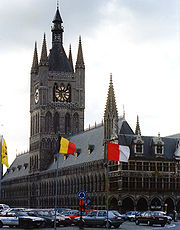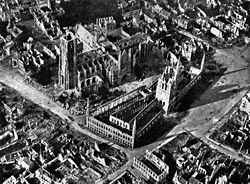
Cloth Hall, Ypres
Encyclopedia

Ypres
Ypres is a Belgian municipality located in the Flemish province of West Flanders. The municipality comprises the city of Ypres and the villages of Boezinge, Brielen, Dikkebus, Elverdinge, Hollebeke, Sint-Jan, Vlamertinge, Voormezele, Zillebeke, and Zuidschote...
, Belgium
Belgium
Belgium , officially the Kingdom of Belgium, is a federal state in Western Europe. It is a founding member of the European Union and hosts the EU's headquarters, and those of several other major international organisations such as NATO.Belgium is also a member of, or affiliated to, many...
, was one of the largest commercial building
Building
In architecture, construction, engineering, real estate development and technology the word building may refer to one of the following:...
s of the Middle Ages
Middle Ages
The Middle Ages is a periodization of European history from the 5th century to the 15th century. The Middle Ages follows the fall of the Western Roman Empire in 476 and precedes the Early Modern Era. It is the middle period of a three-period division of Western history: Classic, Medieval and Modern...
, when it served as the main market and warehouse for the Flemish city's prosperous cloth industry. The original structure, erected mainly in the 13th century and completed 1304, lay in ruins after artillery fire devastated Ypres in World War I
World War I
World War I , which was predominantly called the World War or the Great War from its occurrence until 1939, and the First World War or World War I thereafter, was a major war centred in Europe that began on 28 July 1914 and lasted until 11 November 1918...
. Between 1933 and 1967, the hall was meticulously reconstructed to its prewar condition, under the guidance of architects J. Coomans and P.A. Pauwels. At 125 metres in breadth, with a 70-metre-high belfry
Bell tower
A bell tower is a tower which contains one or more bells, or which is designed to hold bells, even if it has none. In the European tradition, such a tower most commonly serves as part of a church and contains church bells. When attached to a city hall or other civic building, especially in...
tower, the Cloth Hall recalls the importance and wealth of the medieval trade city.

Niche (architecture)
A niche in classical architecture is an exedra or an apse that has been reduced in size, retaining the half-dome heading usual for an apse. Nero's Domus Aurea was the first semi-private dwelling that possessed rooms that were given richly varied floor plans, shaped with niches and exedras;...
. Before the Great War, the niches framed life-size statues of historical personages, counts and countesses of Flanders. The niches on the side wings are now mostly vacant, but those in the centre contain statues of Count Baldwin IX
Baldwin I of Constantinople
Baldwin I , the first emperor of the Latin Empire of Constantinople, as Baldwin IX Count of Flanders and as Baldwin VI Count of Hainaut, was one of the most prominent leaders of the Fourth Crusade, which resulted in the capture of Constantinople, the conquest of the greater part of the Byzantine...
of Flanders and Mary of Champagne, legendary founders of the building; and King Albert I
Albert I of Belgium
Albert I reigned as King of the Belgians from 1909 until 1934.-Early life:Born Albert Léopold Clément Marie Meinrad in Brussels, he was the fifth child and second son of Prince Philippe, Count of Flanders, and his wife, Princess Marie of Hohenzollern-Sigmaringen...
and Queen Elisabeth, under whose reign the reconstruction began. Situated between these two couples, directly above the central archway entrance or Donkerpoort, is a statue of Our Lady of Thuyne, the patron of Ypres.
The belfry, capped with four turret
Turret
In architecture, a turret is a small tower that projects vertically from the wall of a building such as a medieval castle. Turrets were used to provide a projecting defensive position allowing covering fire to the adjacent wall in the days of military fortification...
s and a spire
Spire
A spire is a tapering conical or pyramidal structure on the top of a building, particularly a church tower. Etymologically, the word is derived from the Old English word spir, meaning a sprout, shoot, or stalk of grass....
, houses a carillon
Carillon
A carillon is a musical instrument that is typically housed in a free-standing bell tower, or the belfry of a church or other municipal building. The instrument consists of at least 23 cast bronze, cup-shaped bells, which are played serially to play a melody, or sounded together to play a chord...
with 49 bells. From a pole atop the spire a gilded dragon overlooks the city. The tower offers an expansive view of the surroundings, and was used as a watchtower in centuries past. It has also accommodated the town archives, a treasury, an armory and a prison. In less enlightened times, cat
Cat
The cat , also known as the domestic cat or housecat to distinguish it from other felids and felines, is a small, usually furry, domesticated, carnivorous mammal that is valued by humans for its companionship and for its ability to hunt vermin and household pests...
s, then associated in some way with black magic
Black magic
Black magic is the type of magic that draws on assumed malevolent powers or is used with the intention to kill, steal, injure, cause misfortune or destruction, or for personal gain without regard to harmful consequences. As a term, "black magic" is normally used by those that do not approve of its...
, were thrown off the belfry for reasons that are not clearly understood. Today, a jester commemorates this act by tossing stuffed toy felines from the tower during the triennial Cat Festival
Kattenstoet
The Kattenstoet, Festival of the Cats, is a parade in Ypres, Belgium, devoted to the cat. It is held every third year on the second Sunday of May. Most recently, the 42nd edition took place on May 10, 2009....
.
The Cloth Hall used to be accessible by boat via the Ieperlee waterway, which is now covered. The spacious ground-floor halls where wool and cloth were once sold are now used for exhibitions; the second floor, formerly a warehouse, now hosts the In Flanders Fields Museum
In Flanders Fields Museum
The In Flanders' Fields Museum is devoted to the study of World War I and occupies the second floor of the Cloth Hall, Ypres in Belgium. The building was virtually destroyed by artillery fire during the Battles of Ypres and has been reconstructed. The curator, Piet Chielens, is a World War I...
, dedicated to the history of World War I.
Against the east face of the edifice stands the elegant Nieuwerck, whose Renaissance
Renaissance architecture
Renaissance architecture is the architecture of the period between the early 15th and early 17th centuries in different regions of Europe, demonstrating a conscious revival and development of certain elements of ancient Greek and Roman thought and material culture. Stylistically, Renaissance...
style contrasts markedly with the Gothic
Gothic architecture
Gothic architecture is a style of architecture that flourished during the high and late medieval period. It evolved from Romanesque architecture and was succeeded by Renaissance architecture....
of the main building. Originally built between 1619 and 1622, and reconstructed after the war, this annex now serves as a town hall.
See also
- Belfries of Belgium and FranceBelfries of Belgium and FranceThe Belfries of Belgium and France is a group of 56 historical buildings designated by UNESCO as World Heritage Site, in recognition of an architectural manifestation of emerging civic independence in historic Flanders and neighbouring regions from feudal and religious influences, leading to a...
(UNESCO World Heritage SiteWorld Heritage SiteA UNESCO World Heritage Site is a place that is listed by the UNESCO as of special cultural or physical significance...
) - Battle of YpresBattle of YpresThere were five Battles of Ypres during World War I:*First Battle of Ypres *Second Battle of Ypres...
- Calcutta High CourtCalcutta High CourtThe Calcutta High Court is the oldest High Court in India. It was established as the High Court of Judicature at Fort William on 1 July 1862 under the High Courts Act, 1861. It has jurisdiction over the state of West Bengal and the Union Territory of the Andaman and Nicobar Islands. The High Court...
, a 19th-century copy of the Cloth Hall in KolkataKolkataKolkata , formerly known as Calcutta, is the capital of the Indian state of West Bengal. Located on the east bank of the Hooghly River, it was the commercial capital of East India...
, IndiaIndiaIndia , officially the Republic of India , is a country in South Asia. It is the seventh-largest country by geographical area, the second-most populous country with over 1.2 billion people, and the most populous democracy in the world... - Delaware and Hudson Railway BuildingSUNY System Administration BuildingThe SUNY System Administration Building, formerly the Delaware & Hudson Railroad Building, is a public office building located at the intersection of Broadway and State Street in downtown Albany, New York. Locally the building and land it sits on is referred to as State University Plaza, or the D&H...
, a 20th-century copy of the Cloth Hall in Albany, New YorkAlbany, New YorkAlbany is the capital city of the U.S. state of New York, the seat of Albany County, and the central city of New York's Capital District. Roughly north of New York City, Albany sits on the west bank of the Hudson River, about south of its confluence with the Mohawk River...
, United States
External links
- Ypres: The Cloth Hall from Trabel.com Description and picture gallery from Belgiumview
- In Flanders Fields Museum

